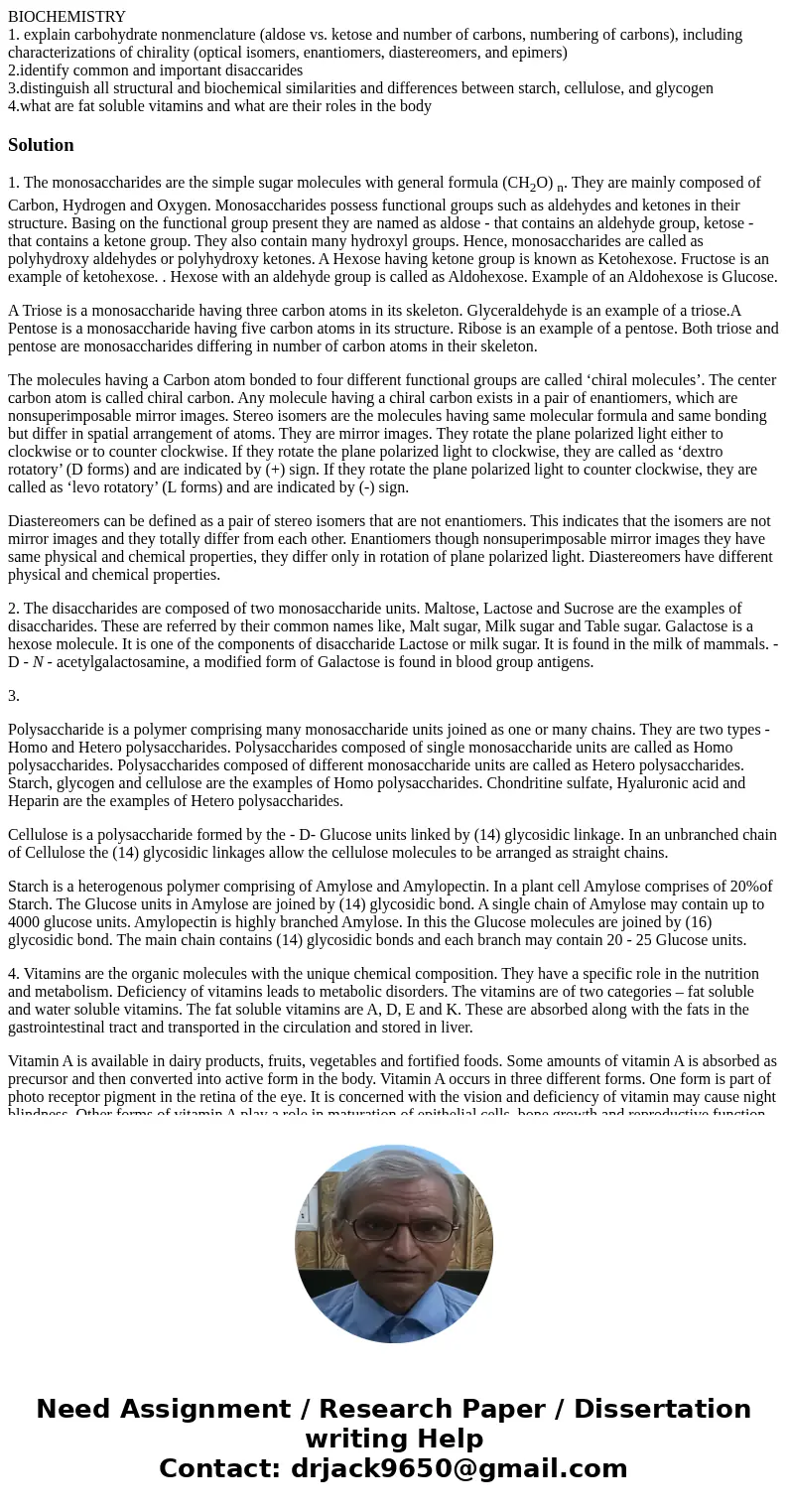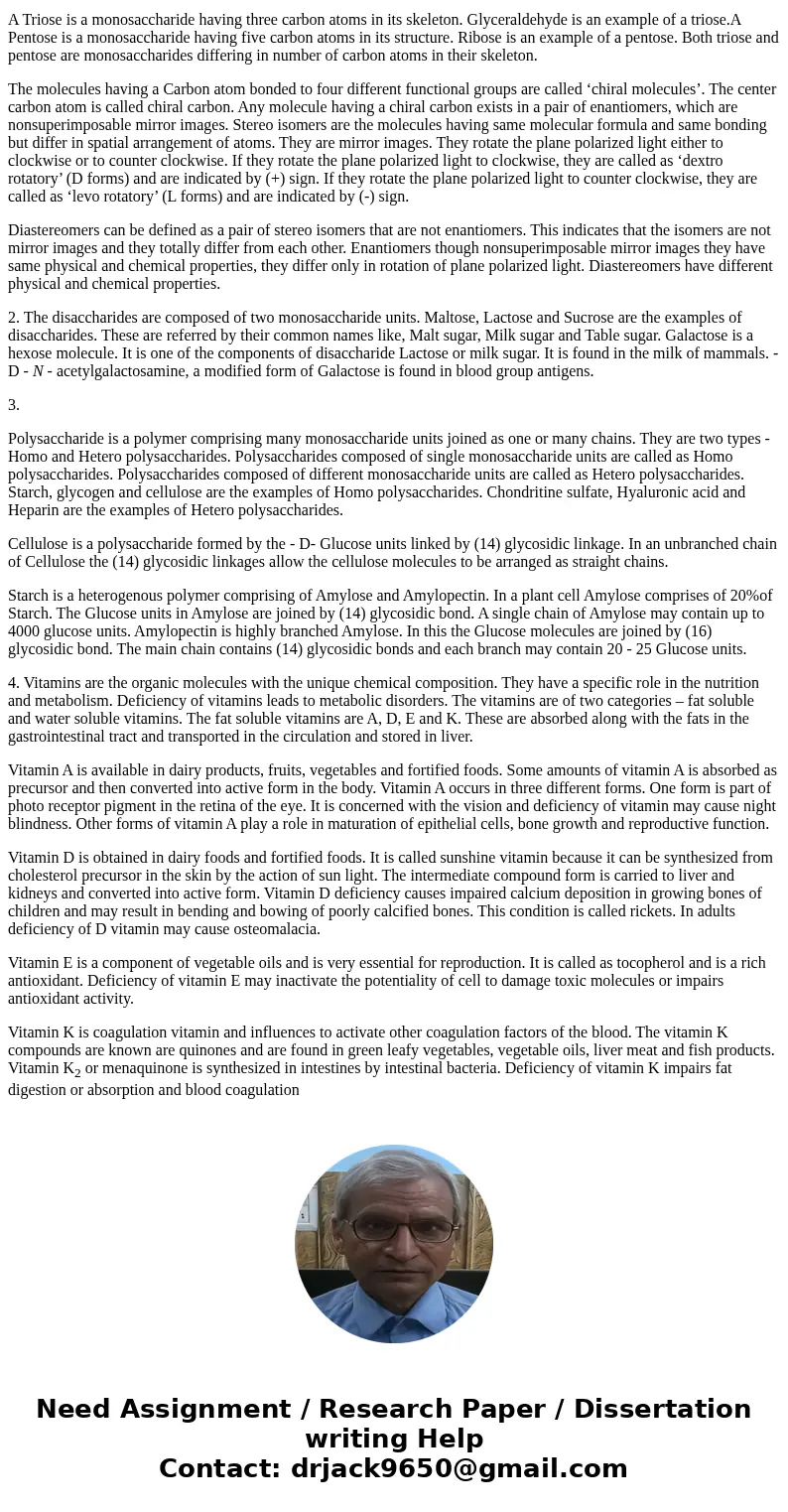BIOCHEMISTRY 1 explain carbohydrate nonmenclature aldose vs
BIOCHEMISTRY
1. explain carbohydrate nonmenclature (aldose vs. ketose and number of carbons, numbering of carbons), including characterizations of chirality (optical isomers, enantiomers, diastereomers, and epimers)
2.identify common and important disaccarides
3.distinguish all structural and biochemical similarities and differences between starch, cellulose, and glycogen
4.what are fat soluble vitamins and what are their roles in the body
Solution
1. The monosaccharides are the simple sugar molecules with general formula (CH2O) n. They are mainly composed of Carbon, Hydrogen and Oxygen. Monosaccharides possess functional groups such as aldehydes and ketones in their structure. Basing on the functional group present they are named as aldose - that contains an aldehyde group, ketose - that contains a ketone group. They also contain many hydroxyl groups. Hence, monosaccharides are called as polyhydroxy aldehydes or polyhydroxy ketones. A Hexose having ketone group is known as Ketohexose. Fructose is an example of ketohexose. . Hexose with an aldehyde group is called as Aldohexose. Example of an Aldohexose is Glucose.
A Triose is a monosaccharide having three carbon atoms in its skeleton. Glyceraldehyde is an example of a triose.A Pentose is a monosaccharide having five carbon atoms in its structure. Ribose is an example of a pentose. Both triose and pentose are monosaccharides differing in number of carbon atoms in their skeleton.
The molecules having a Carbon atom bonded to four different functional groups are called ‘chiral molecules’. The center carbon atom is called chiral carbon. Any molecule having a chiral carbon exists in a pair of enantiomers, which are nonsuperimposable mirror images. Stereo isomers are the molecules having same molecular formula and same bonding but differ in spatial arrangement of atoms. They are mirror images. They rotate the plane polarized light either to clockwise or to counter clockwise. If they rotate the plane polarized light to clockwise, they are called as ‘dextro rotatory’ (D forms) and are indicated by (+) sign. If they rotate the plane polarized light to counter clockwise, they are called as ‘levo rotatory’ (L forms) and are indicated by (-) sign.
Diastereomers can be defined as a pair of stereo isomers that are not enantiomers. This indicates that the isomers are not mirror images and they totally differ from each other. Enantiomers though nonsuperimposable mirror images they have same physical and chemical properties, they differ only in rotation of plane polarized light. Diastereomers have different physical and chemical properties.
2. The disaccharides are composed of two monosaccharide units. Maltose, Lactose and Sucrose are the examples of disaccharides. These are referred by their common names like, Malt sugar, Milk sugar and Table sugar. Galactose is a hexose molecule. It is one of the components of disaccharide Lactose or milk sugar. It is found in the milk of mammals. -D - N - acetylgalactosamine, a modified form of Galactose is found in blood group antigens.
3.
Polysaccharide is a polymer comprising many monosaccharide units joined as one or many chains. They are two types - Homo and Hetero polysaccharides. Polysaccharides composed of single monosaccharide units are called as Homo polysaccharides. Polysaccharides composed of different monosaccharide units are called as Hetero polysaccharides. Starch, glycogen and cellulose are the examples of Homo polysaccharides. Chondritine sulfate, Hyaluronic acid and Heparin are the examples of Hetero polysaccharides.
Cellulose is a polysaccharide formed by the - D- Glucose units linked by (14) glycosidic linkage. In an unbranched chain of Cellulose the (14) glycosidic linkages allow the cellulose molecules to be arranged as straight chains.
Starch is a heterogenous polymer comprising of Amylose and Amylopectin. In a plant cell Amylose comprises of 20%of Starch. The Glucose units in Amylose are joined by (14) glycosidic bond. A single chain of Amylose may contain up to 4000 glucose units. Amylopectin is highly branched Amylose. In this the Glucose molecules are joined by (16) glycosidic bond. The main chain contains (14) glycosidic bonds and each branch may contain 20 - 25 Glucose units.
4. Vitamins are the organic molecules with the unique chemical composition. They have a specific role in the nutrition and metabolism. Deficiency of vitamins leads to metabolic disorders. The vitamins are of two categories – fat soluble and water soluble vitamins. The fat soluble vitamins are A, D, E and K. These are absorbed along with the fats in the gastrointestinal tract and transported in the circulation and stored in liver.
Vitamin A is available in dairy products, fruits, vegetables and fortified foods. Some amounts of vitamin A is absorbed as precursor and then converted into active form in the body. Vitamin A occurs in three different forms. One form is part of photo receptor pigment in the retina of the eye. It is concerned with the vision and deficiency of vitamin may cause night blindness. Other forms of vitamin A play a role in maturation of epithelial cells, bone growth and reproductive function.
Vitamin D is obtained in dairy foods and fortified foods. It is called sunshine vitamin because it can be synthesized from cholesterol precursor in the skin by the action of sun light. The intermediate compound form is carried to liver and kidneys and converted into active form. Vitamin D deficiency causes impaired calcium deposition in growing bones of children and may result in bending and bowing of poorly calcified bones. This condition is called rickets. In adults deficiency of D vitamin may cause osteomalacia.
Vitamin E is a component of vegetable oils and is very essential for reproduction. It is called as tocopherol and is a rich antioxidant. Deficiency of vitamin E may inactivate the potentiality of cell to damage toxic molecules or impairs antioxidant activity.
Vitamin K is coagulation vitamin and influences to activate other coagulation factors of the blood. The vitamin K compounds are known are quinones and are found in green leafy vegetables, vegetable oils, liver meat and fish products. Vitamin K2 or menaquinone is synthesized in intestines by intestinal bacteria. Deficiency of vitamin K impairs fat digestion or absorption and blood coagulation


 Homework Sourse
Homework Sourse